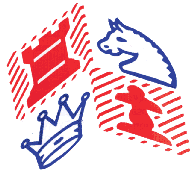Studies Subcommittee in Netania
Studies Subcommittee in Netania
 |
Studies Subcommittee
in Netanya
|
convener/speaker: A. J. Roycroft
Informal minutes
There were the following four items reported verbally to the full Commission.
1. Study of the Year
The FIDE Album 1995-97 judges will be requested to choose one study representing
each of the three years and suitable for popularising studies in non-specialist
chess columns. The selections can be publicised on the Internet.
2. Open Solving
The subcommittee expressed regret that no study was included in the Open
Solving event at Netanya.
3. FIDE Web Site
The subcommittee reported with pleasure that Hannu Harkola (Finland) had
agreed to incorporate official subcommittee material in his FIDE-related
web site for world-wide access by composers, judges and tourney organisers.
The two major items to be displayed will be the Guidelines
for Organisers of Formal International Tourneys for Studies promulgated
at the PCCC Meeting in Bratislava in 1993, and the report set out below.
[Website address: http://www.sci.fi/~stniekat]
4. Studies ‘extracted from databases’
The appended report is a tentative first effort to address a current thorny
subject, and as such is in the nature of a discussion paper rather than
a firm statement. Six signatures – Noam Elkies (Israel/USA) opted not to
sign – were acquired.
Background
Studies extracted from, or suspected of having been extracted from,
‘total information 5-man endgame databases’ as opposed to having been composed
in the time-honoured manner give rise to doubt, controversy and consternation
when they appear in tourney awards. The FIDE Studies Subcommittee that
met at Netanya in 1999 made a first attempt to address this matter. Its
report follows.
PROPOSAL FOR THE GUIDANCE OF
TOURNEY ORGANISERS, COMPOSERS AND JUDGES
0. DEFINITIONS
conversion – the consequence of a move in an odb solution (ie
series of optimal moves by both sides) where the force present changes,
ie by capture or promotion.
database – see odb
depth – the number of consecutive optimal moves needed by the winning
side to checkmate or to conversion.
metric – the component of the algorithm used to generate on odb
whereby the program can refer to all target winning positions. There are
in general only two metrics: checkmate; and (winning) conversion. The first
task of the algorithm is to obtain or generate all winning positions according
to the chosen metric.
odb – ‘oracle’ database, otherwise known as total information database
or tablebase. An odb is generated by algorithm implemented by computer
program for specific chess force. When complete an odb can yield on request
the true result of any position for the force in question, the optimal
move or moves (if any) where there is a win, and similarly the depth. Odb’s
for five chessmen (the kings included, but with no more than a single pawn)
have been in the public domain since the 1980’s. Pawnless odb’s with six
chessmen have been generated and many results published, but with rare
exceptions six-man odb’s are not yet (in 1999) publicly available. It is
commonly assumed that odb’s for one more chessman will be produced every
ten years. Although not in general use the term ‘oracle database’ is useful
to distinguish it from other types of database.
optimal – an optimal move in a position that is a win is a move
that will win in fewer moves than any other move (if any), or a move of
the defence that will delay loss longest. A similar definition can be applied
to a position that is drawn. Technically, an optimal move by the winning
side reduces the depth by 1, and an optimal move by the defender maintains
the depth unaltered. See also metric.
table-base – a compressed odb.
1. In recent years judges and editors have been faced with the insurmountable
difficulty of distinguishing between a ‘malyutka’ (five men only) study
composed traditionally and one that may have been extracted from an odb.
The studies subcommittee has considered the situation and reports as follows.
2. The skills needed to extract ‘studies’ (ie optimal series of unique
moves to win or to draw) from an odb are distinct from the talent, creativity,
technique and persistence needed for traditional study composing.
3. The subcommittee proposes two principles:
3.1 Traditional and odb studies should not compete in the same tourney.
3.2 However, the use of computers should be encouraged, because they can
both assist in ensuring soundness and be a source of ideas.
4. The subcommittee therefore makes the following recommendations.
4.1 The use of odb’s to verify the correctness of variations is acceptable.
4.2 The use of odb output in a main line is acceptable, provided only that
the initial position has at least one more chessman present than is the
maximum supported by odb’s on the market.
4.3 Obscure lines of play should be accompanied by prose text explaining
what is happening. This explanation must satisfy the judge. The source
of the text may be collective.
4.4 Separate tourneys for odb ‘studies’ should be organised.
4.5 Judges of study tourneys should familiarise themselves with odb technology
and with current publicly available odb’s.
Signed:
John Roycroft (speaker),
London
Hillel Aloni, Netanya
Ofer Comay, Israel
Gady Costeff, Israel and USA
David Gurgenidze, Tbilisi
Nikolai Kralin, Moscow
Netanya, October 1999
|
Invitation
to Netanya | PCCC in Netanya






